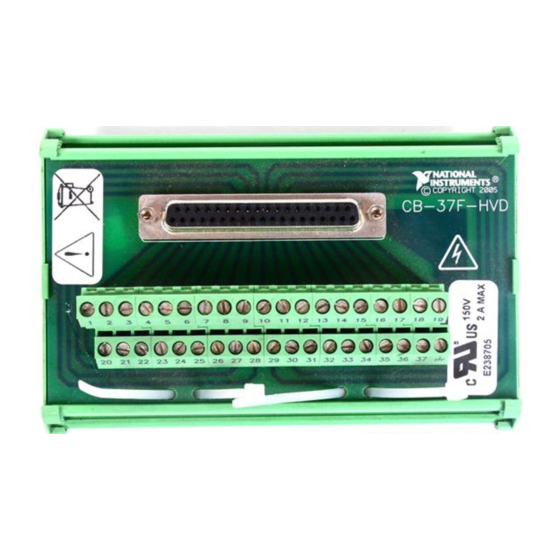Table of Contents
Advertisement
Quick Links
INSTALLATION GUIDE
NI CB-37F-HVD
High-Voltage DIN Rail Screw Terminal Block for Rack Mount Users
Using the Terminal Block Safely with High Voltage
Signals
Failure to adhere to the following precautionary steps when connecting the cable
Caution
to a high-voltage NI device can result in electrical shock or death.
Caution
Before you begin installation, ensure that no high-voltage signals are connected
to your accessory.
Caution
Signal connections should be made by a qualified technician or service personnel.
Caution
When using this product with UL listed high-voltage PCI or PXI devices, the
connecting cable must be keyed for hazardous voltage (>30 Vrms, 42.4 V
using the 37-Pin High-Voltage Accessory Kit. This kit is provided with the PCI/PXI device
or can be ordered separately for replacement (part number 779445-01). Refer to the 37-Pin
High-Voltage Accessory Safety Kit Installation Guide provided in the kit for installation
instructions.
This guide describes how to install and use the National Instruments
CB-37F-HVD 37-pin D-SUB high-voltage (150 V) DIN rail terminal
block. The CB-37F-HVD has screw terminals for connecting up to 37 I/O
signals. Use 12–30 AWG wire to connect to the CB-37F-HVD screw
terminals.
The CB-37F-HVD is UL recognized. You can use the CB-37F-HVD
terminal block with low-voltage or high-voltage products up to 150 V.
When hazardous voltages (>30 Vrms, 42.4 V
any terminal, all terminals must be considered hazardous. Ensure that
external wiring or any circuits connected to the device are properly
insulated from human contact.
, 60 VDC) are present on
pk
, 60 VDC)
pk
Advertisement
Table of Contents

Subscribe to Our Youtube Channel
Summary of Contents for National Instruments NI CB-37F-HVD
- Page 1 NI CB-37F-HVD High-Voltage DIN Rail Screw Terminal Block for Rack Mount Users This guide describes how to install and use the National Instruments CB-37F-HVD 37-pin D-SUB high-voltage (150 V) DIN rail terminal block. The CB-37F-HVD has screw terminals for connecting up to 37 I/O signals.
- Page 2 UL listed industrial enclosure , electrical cabinet, or rack-mount cabinet National Instruments sells two UL listed industrial enclosures: FP-ENC1 industrial enclosure with polycarbonate window (part number 777596-01) and NI FP-ENC1 industrial enclosure with solid metal door (part number 777596-02). NI CB-37F-HVD Installation Guide...
- Page 3 To connect signals to the CB-37F-HVD terminal block, refer to Figure 2 while completing the following steps. Refer to the Read Me First: Safety and Radio-Frequency Interference document Note before removing equipment covers or connecting or disconnecting any signal wires. © National Instruments Corporation NI CB-37F-HVD Installation Guide...
- Page 4 To replace the zip ties, remove one of the end pieces from the CB-37F-HVD. Slide Note the PCB out and guide the zip tie through the holes on the PCB. Replace the PCB, end piece, and screws. NI CB-37F-HVD Installation Guide ni.com...
-
Page 5: Specifications
Weight............ 210 g (7.5 oz) Maximum Voltage Maximum voltage refers to the signal voltage plus the common-mode voltage. Channel-to-ground ......... 150 V In instrumentation terminology, DC coupling means that both DC and AC signals are passed. © National Instruments Corporation NI CB-37F-HVD Installation Guide... - Page 6 UL 508 • CAN/CSA-C22.2 No. 14 Note For the UL certification, refer to the product label or visit , search by model number or product line, and click the ni.com/certification appropriate link in the Certification column. NI CB-37F-HVD Installation Guide ni.com...
- Page 7 Instruments trademarks. Other product and company names mentioned herein are trademarks or trade names of their respective companies. For patents covering National Instruments products, refer to the appropriate location: Help»Patents in your software, the patents.txt file on your CD, or ni.com/patents.














Need help?
Do you have a question about the NI CB-37F-HVD and is the answer not in the manual?
Questions and answers